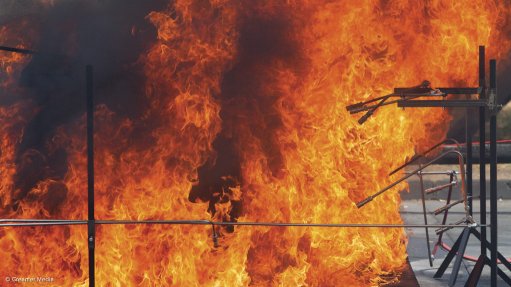
GENERATOR FIRES Flammable liquid and hot components can easily cause a fire
Companies need to service generators regularly to lessen the fire hazard risk they pose, says risk management company ASP Fire CEO Michael van Niekerk.
“A generators is used only occasionally and is generally ‘tucked away in a corner’, so management tends to forget that it can potentially be a fire hazard. Generators contain flammable liquid and hot components that can easily cause a massive fire.”
He notes that the main problem is that most business owners are focused on the production or service provision, neglecting the importance of having fire-prevention systems in place.
“For instance, hospitals must start their generators once a week to inspect fuel levels and functionality. All companies should follow this example, as this lessens the chance of a fire breaking out as all tanks, pipes and cables are checked.”
Most companies employ a building facility and maintenance manager to service all equipment – from air conditioners and compressors to sprinkler pump checks – explains Van Niekerk, who advises businesses to include generator inspection as part of these managers’ job description.
“They should be responsible for the generator, ensuring that there is no litter or vegetation around the generator, as well as no oil and diesel spills, cans or drums.”
Van Niekerk says most local bylaws allow for up to 1 000 ℓ of diesel to be stored for a standby generator, but it depends on legislation.
If this amount is exceeded, authorisation is needed. Most diesel generators come with an integrated tank, but it is always convenient to have a 210 ℓ drum of diesel on hand in case of power outages.
No matter the amount stored, local bylaws and the SANS 10400-T standard require a dry chemical powder (DCP) fire extinguisher to be provided for flammable liquid protection.
However, Van Niekerk says this obscures vision when discharged, especially if generators are in enclosed areas.
“DCP extinguishers knock down the flame because the mono-ammonium phosphate chemically reacts with the fire to extinguish it, but it does not cool anything down.”
He explains that, if components or surfaces are still very hot and flammable liquids are present, a second fire can start.
Van Niekerk explains that water mist or foam mist fire extinguishers are optimal because they will knock the flames down and cool off any hot components or surfaces, ensuring that a second fire does not start.
Another advantage of using a foam mist extinguisher is that it creates a layer of foam over spilt fuel or oil, so that even if there are ignition sources, it cannot reignite because it is smothered from oxygen.
Location, Location, Location
It is also important not to place a fire extinguisher next to a generator because, should there be a fire, the extinguisher must be easily accessible. “Some people also put extinguishers inside generator rooms – if there is a big fire, you will not be able to get to that extinguisher,” Van Niekerk warns.
He says most people are not aware that they place generators in fire-sensitive areas, as generators are usually placed “dangerously close” to a building in an attempt to be economic, as cables connecting generators to buildings can be very expensive.
“Some people will put a generator right next to a fire hydrant and that means we cannot get to it during a fire,” Van Niekerk says, emphasising the importance of the location of generators and associated equipment.